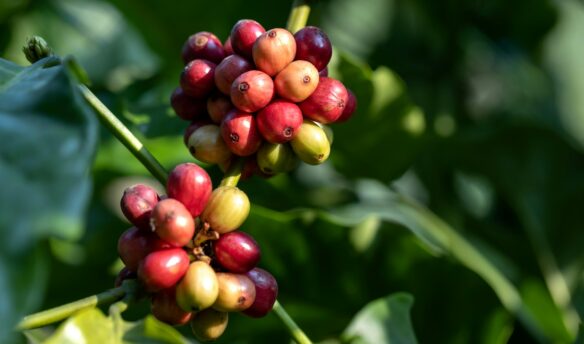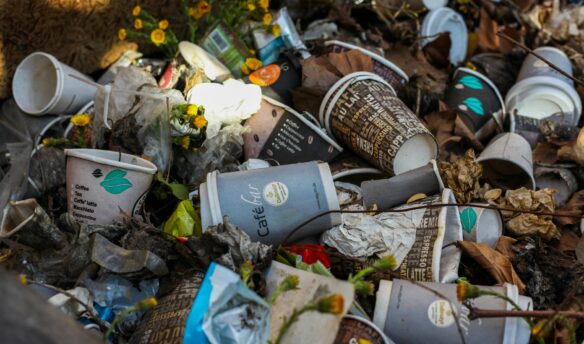Does your morning coffee glow? It might be microplastics. Plus, someone in New Mexico really doesn’t like Starbucks, and big companies are expanding their coffee buying beyond Brazil and Vietnam.
‘The World’s Coffee Mostly Comes From Two Countries. That’s a Problem’ – via Bloomberg
Nearly half of all coffee grown worldwide comes from either Brazil or Vietnam and when bad weather hits both countries simultaneously—which happened this year—coffee prices skyrocket. Due partially to unpredictable weather patterns, robusta futures reached their highest peak since the 1970s, while arabica prices increased 30% in 2024.
As the impact of climate change worsens, relying on just two countries to produce more than half the world’s coffee is risky. Many coffee multinationals are turning to smaller producing countries to hedge their bets, according to Ilena Peng and Tarso Veloso reporting for Bloomberg.
Starbucks is financing loans to producers in Rwanda, Peru, and Tanzania; green trader Volcafe raised $60 million to expand its operations in East Africa; and Nespresso and Lavazza have programs to revive production in countries where coffee farming once thrived but has since declined like Cuba, the Democratic Republic of Congo, Zimbabwe, and more. Illy, meanwhile, has restarted purchasing coffee from African countries from where it used to source, as well as “expanding procurement from current suppliers outside Brazil and Vietnam.”
“There is an urgency now, because this year proves that the impact of climate change cannot be underestimated,” Andrea Illy, CEO of Illycaffe, told Bloomberg. “It is starting to change the market itself.”
Although specialty coffee drinkers have likely had coffees from many of the countries listed above, larger brands tend to source most of their coffee catalogs from Brazil and Vietnam. Big brands might also feel the pressure to compete with specialty coffee: According to the National Coffee Association, almost half of all American adults now drink specialty coffee daily.
The shift away from Brazil and Vietnam benefits producers in countries like Honduras, many of whom have increased their production to meet demand. However, despite the boom, Bloomberg reports that farmers in Honduras are dealing with higher production costs and lower profit margins.
In other countries, price increases have led farmers to focus on specialty “because it is deemed much more profitable to the farmers in general,” said Praewa Boonyawan, a coffee producer in Thailand. “There is certainly a higher demand on the consumer side.”
‘The Coffee Farmer Thriving Index Says ‘Listen to the Farmers” – via Daily Coffee News
Farmers in Rwanda and Uganda are struggling, according to a report from the social impact assessment company 60 Decibels.
In partnership with the Irish nonprofit Small Foundation, 60 Decibels conducted phone interviews with thousands of coffee producers in Uganda and Rwanda to produce the Coffee Farmer Thriving Index. This new report, the company says, offers a “standardized and holistic measure of farmer wellbeing.”
More than a third of the Ugandan producers reported they made no profit the previous year, while 21% lost money. The report states that farmers “are vulnerable to market fluctuations and climate conditions, which makes harvest seasons unpredictable.”
Other key takeaways include:
- Nearly a third of Ugandan coffee farmers are “food stressed,” which the Integrated Food Security Phase Classification defines as “households have minimally adequate food consumption but are unable to afford some essential non-food expenditures.”
- Forty-six percent of Ugandan farmers reported they couldn’t save any money in the past year, saying they would find it challenging to get emergency funds.
- Just 19% of respondents had reliable access to agricultural extension services like education or training programs and reported having even lower access to other essential services like credit (11%) and insurance (2%). Farmers associated with a cooperative had more access to such services than independent farmers.
The report’s authors note that even within one country like Uganda, farmers have myriad different experiences and circumstances, and any conclusions or recommendations must be seen with that context in mind. “Therefore, we have no universal recommendation to improve farmer wellbeing beyond this: listen to the farmers. They know if they are thriving or barely surviving, and they know what they need.”
‘Starbucks to Charbucks: Taos Chafes at Coffee Chain’ – via Reuters
When residents wish to object to a new corporate development in their small town, they have a few choices: organize a petition, threaten a boycott, or protest. Or, for one (or many) anonymous residents of Taos, New Mexico, there seems to be another option: arson.
A development site for a new Starbucks in the New Mexico town has been attacked twice, with both incidents determined to be arson, or intentionally setting a fire. The events led locals to nickname the project “Charbucks.”
The development would be the first drive-thru Starbucks in Taos, a mountain town with a history of militant opposition to corporate chains. As Andrew Hay reported for Reuters: “From the 1680 Indigenous Pueblo Revolt against Spanish settlement, to the 1847 Taos Revolt against U.S. occupation and more recently an arson attack on a development tycoon and opposition to a billionaire’s ski resort development, Taos locals have resisted outside forces.”
The town, known for its art and ski scenes and the Taos Pueblo UNESCO World Heritage Site, has experienced an influx of remote workers since 2020, widening the area’s social inequalities. The Taos town council supported the new development because it would bring jobs and tax revenue.
However, opening a new Starbucks wouldn’t help solve a critical housing issue, said coffee shop owner Andrea Mayer. “People are showing up saying ‘I’d love to work here, I can’t afford to live here,'” Meyer said.
Police told Reuters they believed they knew the culprit (or culprits) but lacked the evidence needed to make an arrest.
Locals believe the attacks are rooted in trying to deter the brand from building a new location but are divided on the extreme tactic. “We don’t know who did it, but we loved it,” Todd Lazar, a holistic healer, told Reuters. Others, like Pablo Flores, who owns a specialty coffee roaster in town, are more circumspect. “Taos is changing and if you don’t like the way it’s changing, do not support that business,” he said. However, “Don’t burn it down, that’s not cool.”
More News
‘Coffee Traders Rush to Ship Beans Ahead of EU Deforestation Law‘ – via Bloomberg
‘Colorado Specialty Coffee Company Files for Chapter 11 Bankruptcy‘ – via Daily Coffee News
‘City Recycles More Than 2.3 Million Coffee Pods’ – via BBC News
‘Soaring Coffee Prices Force Roasters to Add Lower-cost Beans to Blends’ – via Financial Times
‘New ICE Platform to Trace Cocoa, Coffee Deforestation From Space‘ – via Bloomberg
‘Attention All Roasters, Read the Business of Roasting Report’ – via Daily Coffee News
‘Ethiopia Faces Market Losses Due to Ban on Coffee Exports to Producing Countries’ – via Capital
‘Coffee Growers Association Campaigns to Protect Authenticity of the Cerrado Mineiro Origin‘ – via Tea & Coffee Trade Journal
Is Coffee Good For You?
In past issues of the newsletter, we told you there could be microplastics in your coffee, leaching out from disposable coffee cups. A study from 2022 found that drinking a single cup of to-go coffee every week could cause you to consume 90,000 microplastic particles every year.
Microplastics testing equipment is usually expensive and cumbersome, but researchers at the University of British Columbia have built a portable, affordable device to let you check what’s in your morning coffee, according to Darryl Greer for the Toronto Star.
The 3D-printed device allows users to test liquid samples: any microplastics will glow! The device also will run an algorithm to analyze and calculate the number of microplastics in the sample. Results are then sent to a smartphone.
According to creator Tianxi Yang, an assistant professor in the faculty of land and food systems, the goal is to raise awareness of microplastics in their everyday life. “I think the micro and nanoplastics detection is very meaningful because it allows people to realize how much micro and nanoplastics they’re being exposed to, even though they may not notice,” Yang told the Toronto Star.
The dangers of microplastics to human health are still being researched, and scientists are wary of linking them to specific diseases. However, microplastics have been shown to damage human cells, can breach the blood-brain barrier, and have been found in our arteries and our lungs.
Beyond the Headlines
‘The Pesticides Underpinning Coffee’s Healthy Image’ by Fionn Pooler
‘It’s Time to Start Talking About Human Resources in Coffee’ by Eric Grimm
















